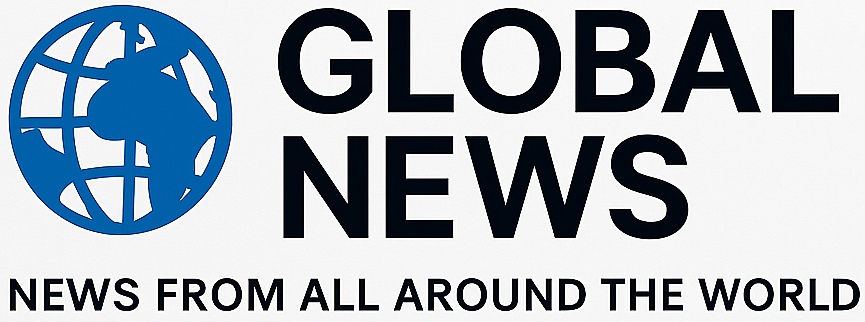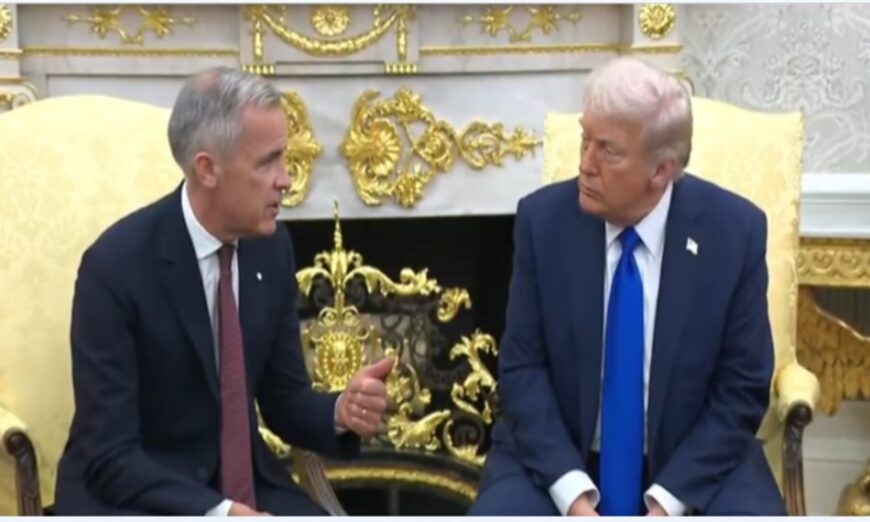US President Donald Trump met Canadian Prime Minister Mark Carney at White House yesterday.
This is the second meeting between the two leaders after Mr Carney took office in March this year. During the meeting, both leaders discussed the tariffs and a possible free trade agreement between Canada, the US and Mexico.
Addressing the press after the meeting, Mr Trump advocated for lower foreign tariffs on American farmers by saying that Canada was charging very high tariffs on America’s agricultural products.
US President Donald Trump on Tuesday once again referred to Canada as the 51st state of the US, this time during a meeting with Canadian Prime Minister Mark Carney. During their bilateral meeting at the Oval Office, Trump joked about a possible merger of Canada and the United States.
Trump stated that he and Carney will be talking about certain aspects of the US-Canada relationship, including Canada’s recent recognition of statehood for Palestine.
“We’ve had some natural conflict, but we’ll probably work that out. We’ve had a strong relationship, and your hosting of the various countries that showed up was a beautiful job you did, and I appreciate it very much. We’re going to be talking about trade. We’re going to be talking about different things. We’ll certainly be talking about Gaza.,” said Trump.
The Canadian PM lauded Trump’s actions and called him a ‘transformative President.’
“You are a transformative president. Since then, transformation in the economy, unprecedented commitment to the NATO partners to defence spending. Peace from India, Pakistan, Azerbaijan and Armenia. Disabling Iran as a force of terror,” he said.
Also Read | War in Gaza enters third year amid Trump’s peace plan bid with Israel, Hamas
As Carney continued to praise Trump, the Labour leader highlighted the agenda for their discussion, “This is, in many respects, the most important…”
Trump butted in, “The merger of Canada and the United States!”‘ triggering a serious of laughs across the room.
In his last visit to the White House, Carney had responded to Trump, telling him that Canada will never be up for sale.
Carney’s visit to the White House comes amid the ongoing trade tensions between Canada and the US, especially due to Trump’s tariffs on the neighbouring country.
The Canadian PM’s visit comes as Trump increased the tariff on steel, autos, digital services and more, which will impact the Canadian economy as well.
During bilateral talks at the White House, Carney gave credit to Trump’s influence on global affairs and economic stability.
“You are a transformative president the transformation in the economy, unprecedented commitments of Nato partners to defence spending, peace from India, Pakistan through to Azerbaijan, Armenia, disabling Iran as the force of terror,” Carney said in the Oval Office, as Trump nodded in response.
Carney, who took office in March, previously met Trump in May during an earlier visit to Washington.
His remarks on Tuesday signal a notable shift in Canada’s stance after months of diplomatic unease over Trump’s tariff threats and the controversial remarks he made earlier this year claiming that Canada should be “annexed” into the United States.
Trump, in a separate address on Monday, again took credit for using tariffs to stop global wars, including one between India and Pakistan. He argued that the United States’ trade leverage had positioned it as a “peacekeeping” nation.
“If I didn’t have the power of tariffs, you would have at least four of the seven wars raging,” Trump said. “If you look at India and Pakistan, they were ready to go at it. Seven planes were shot down… I don’t want to say exactly what I said, but what I said was very effective.”
Since May 10, when Trump repeated that India and Pakistan had agreed to a “full and immediate” ceasefire after a “long night” of discussions reportedly mediated by Washington, he has repeated the claim nearly 50 times, asserting that his diplomatic efforts “helped settle” tensions between the two nuclear-armed neighbours.
India, however, has firmly rejected any suggestion of third-party mediation. The Ministry of External Affairs (MEA) has repeatedly maintained that the ceasefire understanding was reached directly through established military communication channels between the Directors General of Military Operations (DGMOs) of India and Pakistan.
India launched Operation Sindoor on May 7, targeting terror infrastructure across Pakistan and Pakistan-occupied Kashmir in retaliation for the April 22 Pahalgam attack, which killed 26 civilians. The cross-border exchanges escalated into four days of intense drone and missile strikes before the two sides agreed to a cessation of hostilities on May 10.
Despite New Delhi’s denials, Trump has continued to portray himself as the key mediator who “prevented a major war” in South Asia.
Since May 10, when Trump repeated that India and Pakistan had agreed to a “full and immediate” ceasefire after a “long night” of discussions reportedly mediated by Washington, he has repeated the claim nearly 50 times, asserting that his diplomatic efforts “helped settle” tensions between the two nuclear-armed neighbours.
India, however, has firmly rejected any suggestion of third-party mediation. The Ministry of External Affairs (MEA) has repeatedly maintained that the ceasefire understanding was reached directly through established military communication channels between the Directors General of Military Operations (DGMOs) of India and Pakistan.
India launched Operation Sindoor on May 7, targeting terror infrastructure across Pakistan and Pakistan-occupied Kashmir in retaliation for the April 22 Pahalgam attack, which killed 26 civilians.
The cross-border exchanges escalated into four days of intense drone and missile strikes before the two sides agreed to a cessation of hostilities on May 10.
Despite New Delhi’s denials, Trump has continued to portray himself as the key mediator who “prevented a major war” in South Asia.

